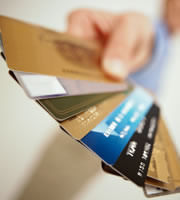Credit card rates hold firm in early April

April 15, 2014
Current averages:
- Average consumer credit card rate, overall market: 16.99 percent
- Average consumer non-rewards credit card rate: 15.48 percent
- Average consumer rewards credit card rate: 17.64 percent
- Average student credit card rate: 17.56 percent
- Average business non-rewards credit card rate: 14.99 percent
- Average business rewards credit card rate: 15.41 percent
The U.S. bank prime rate stayed at 3.25 percent during the first half of April.
None of the credit card offers tracked by this survey changed in early April, and indeed, no clear interest rate trend has emerged so far in 2014. This can largely be chalked up to uncertainty over the economy. After gaining momentum throughout most of 2013, the economy seemed to lose steam in the fourth quarter. This raised questions about what impact higher mortgage rates were having on the economy. Then, a particularly harsh winter added to the uncertainty, as it was unclear how much of the economy’s sluggishness should be attributed to the weather.
In the context of this uncertainty, the most significant economic announcement in early April was the Bureau of Labor Statistics’ report on employment for March. A net total of 192,000 new jobs were added in March, exceeding the average job growth of 183,000 over the prior 12 months. On top of that, a total of 37,000 new jobs were added to the prior estimates of January and February employment growth. These signs of a stronger job market may indicate that economic growth is back on track.
One reservation people have about stronger growth is that it can lead to higher interest rates — especially now, when weak growth has prompted the Federal Reserve to pursue low interest rate policies. However, since most credit card debt is unsecured, the offset to rising interest rates can be that credit card companies gain more credit confidence in an improving economy, allowing them to reduce the interest rate cushion they charge to protect against defaults.
Given this offset between growth and credit confidence, the deciding factor as to whether an improving economy leads to higher credit card rates may well be inflation. Along with continued job growth, inflation will be a key factor to watch in the months ahead.
Consumer credit card rates
Consumer credit card rates have enjoyed an extended period of stability, with no change in any of the consumer credit card offers tracked by this survey since last October.
Consumers should take advantage of this stability to re-assess their credit cards. In particular, consumers who regularly carry a balance on their credit cards should take a long, hard look at credit cards to find the lowest rate possible. This may mean shifting from rewards credit cards to non-rewards cards. While rewards are a cost-free benefit for consumers who do not carry month-to-month balances on their credit card bills, for those consumers who carry substantial balances, the additional interest typically charged by rewards programs may exceed the value of the rewards.
Student credit card rates
The average rate on student credit cards tracked by this survey has been unchanged since February.
Business credit card rates
After the average rate on business rewards credit cards rose by 10 basis points in the last survey, rates on both business rewards and non-rewards credit cards held steady in the first half of April. This stability gives managers an opportunity to evaluate the cost-effectiveness of rewards programs, and to research the best credit card terms for the needs of the company.
Excellent credit vs. average credit
Consumers who have maintained excellent credit histories will usually be rewarded in the form of lower credit card rates. The size of this reward can be measured as the difference between the rates offered for consumers with excellent credit and the overall average credit card rate. Currently, this differential is 3.93 percent.
In total, IndexCreditCards.com surveys information from nearly 50 different credit cards, and includes multiple credit-rating tiers from many of those cards. Examples of offers surveyed include American Express, Capital One, Chase, Citi, Discover, and other MasterCard and Visa branded cards. The information compiled not only demonstrates trends in credit card rates over time, but also indicates the different values credit card companies put on different target markets (consumer, business, etc.), as evidenced by the differences between rates for those markets.
Disclaimer:The information in this article is believed to be accurate as of the date it was written. Please keep in mind that credit card offers change frequently. Therefore, we cannot guarantee the accuracy of the information in this article. Reasonable efforts are made to maintain accurate information. See the online credit card application for full terms and conditions on offers and rewards. Please verify all terms and conditions of any credit card prior to applying.
This content is not provided by any company mentioned in this article. Any opinions, analyses, reviews or recommendations expressed here are those of the author’s alone, and have not been reviewed, approved or otherwise endorsed by any such company. CardRatings.com does not review every company or every offer available on the market.
Published